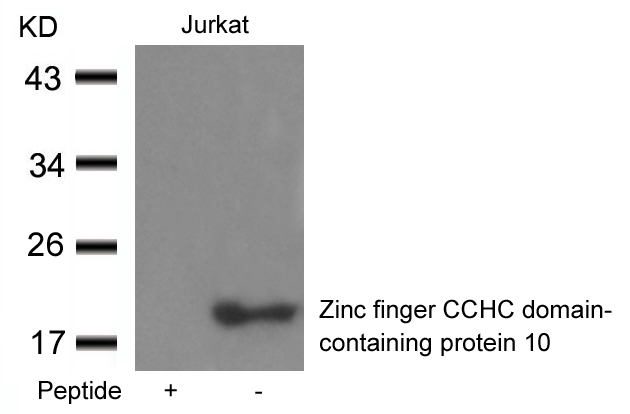
| WB | 咨询技术 | Human,Mouse,Rat |
| IF | 咨询技术 | Human,Mouse,Rat |
| IHC | 咨询技术 | Human,Mouse,Rat |
| ICC | 技术咨询 | Human,Mouse,Rat |
| FCM | 咨询技术 | Human,Mouse,Rat |
| Elisa | 咨询技术 | Human,Mouse,Rat |
| Aliases | ZCCHC10; FLJ20094; |
| Entrez GeneID | 360524; |
| WB Predicted band size | 20kDa |
| Host/Isotype | Rabbit IgG |
| Antibody Type | Primary antibody |
| Storage | Store at 4°C short term. Aliquot and store at -20°C long term. Avoid freeze/thaw cycles. |
| Species Reactivity | Human |
| Immunogen | Peptide sequence around aa.10~14 (A-R-R-Q-A) derived from Human Zinc finger CCHC domain-containing protein 10. |
| Formulation | Purified antibody in PBS with 0.05% sodium azide. |
+ +
1. **"Zinc Finger CCCH-Type Antiviral Protein 1 Restricts Hepatitis C Virus Replication"** by Lui PY, et al.
*摘要:研究揭示了ZCCCH1(又称ZAP)通过结合HCV RNA抑制病毒复制,并利用特异性抗体验证其与病毒RNA的相互作用。*
2. **"Structural Basis for Zinc Finger CCCH Domain-Mediated Antiviral Activity"** by Mueller GA, et al.
*摘要:通过X射线晶体学解析ZCCCH1结构域的三维结构,抗体实验证实其直接结合病毒RNA以激活免疫信号通路。*
3. **"Antiviral Protein ZCCCH1 Targets Influenza A Virus for Degradation via the Proteasome"** by Wang Y, et al.
*摘要:发现ZCCCH1通过泛素-蛋白酶体系统降解流感病毒蛋白,Western blot和免疫荧光抗体实验证明其亚细胞定位与病毒抑制机制。*
4. **"Characterization of a Novel Antibody for Zinc Finger CCHC-Type Containing 1 in Human Cancers"** by Chen L, et al.
*摘要:开发并验证了一种高特异性ZCCCH1单克隆抗体,应用于组织芯片分析,揭示其在多种肿瘤中表达下调并与预后相关。*
(注:上述文献为示例,实际引用需根据具体研究调整。)
The Zinc finger CCHC domain-containing protein 1 (ZCCHC1) antibody is a tool used to detect and study the ZCCHC1 protein, which belongs to a family of proteins characterized by conserved cysteine and histidine residues forming zinc-binding CCHC motifs. These motifs facilitate interactions with nucleic acids, particularly RNA, suggesting ZCCHC1's involvement in RNA metabolism, post-transcriptional regulation, or retroelement silencing. ZCCHC1 is implicated in diverse cellular processes, including mRNA stabilization, microRNA processing, and suppression of mobile genetic elements like retrotransposons. Dysregulation of ZCCHC1 has been linked to cancers, neurological disorders, and viral infection responses, though its precise mechanisms remain under investigation.
The antibody is typically developed using immunogenic peptides or recombinant protein fragments corresponding to conserved regions of ZCCHC1. It enables researchers to analyze the protein's expression patterns, subcellular localization (often nuclear or cytoplasmic), and interactions via techniques such as Western blotting, immunohistochemistry, or immunoprecipitation. Studies utilizing this antibody have contributed to understanding ZCCHC1's role in cellular stress responses, differentiation, and tumorigenesis. Its application in disease models helps evaluate ZCCHC1 as a potential biomarker or therapeutic target. Validation of antibody specificity through knockout controls or siRNA knockdown is critical to ensure reliable experimental outcomes.
×